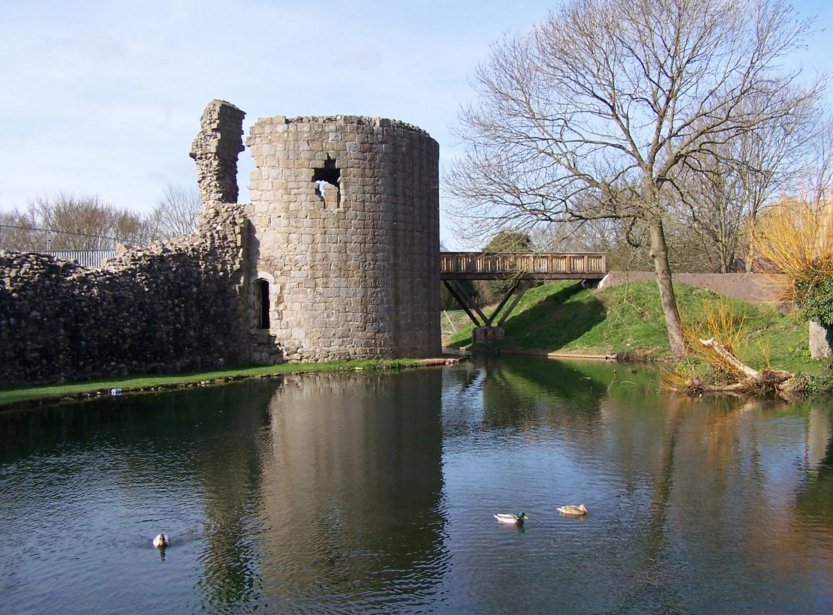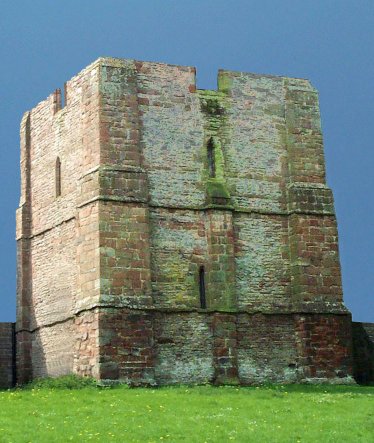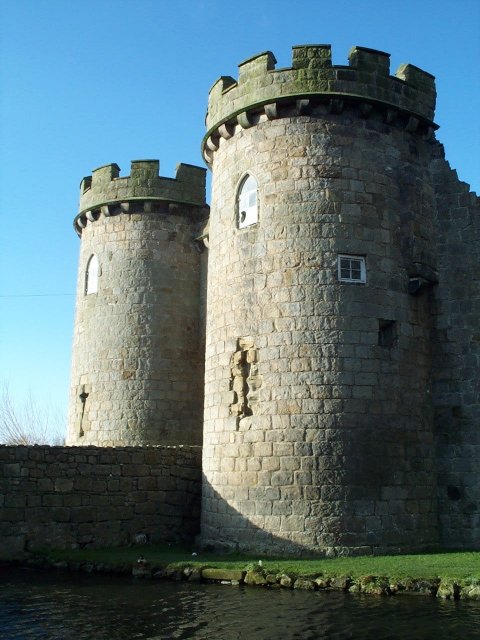Whittington

Whittington castle is well-known for its photogenic gatehouse and, of late, with Arthurian romance and the story of the Holy Grail. Yet Whittington's true beauty is far greater than this. The castle was founded upon the remains of a prehistoric earthwork that may have been a site of ancient Druidic worship. It is possible that the first citadel built here was the ancient hall of Pengwern, long sought for in the Marches of Shropshire. A long dark age poem that mentions the battle of Oswestry in 641 also tells of King Cynddylan and his life and death, as well as the destruction of his hall at the head of the marsh. It is quite feasible that this hall lay under the site of Whittington castle.
 The real
history of Whittington castle begins in the early twelfth
century. The castle was most probably founded, along with the
nearby castles of Overton and Chirk, during the summer of 1114, when King Henry I
(1100-1134) invaded
Wales. The founder of the castle was
William Peverel of Dover, and not his namesake of Nottingham which was
first wrongly asserted as long ago as the end of the thirteenth
century. Much of Whittington castle's early history has been
bound
up with the Fitz Warin Romance, a romantic work which has caught the
attention of
many interested in the Fitz Warin story. Unfortunately the
author of this Romance was on shakey historical ground when he wrote
his 'history'. He therefore created quite a mess with his
muddled
story of the foundation of Whittington castle and his tale of Warin
of Metz, the hero ancestor of the house of Fitz Warin. In
this
new book on Whittington castle the convoluted geneaology of the house
of Fitz Warin is
meticulously worked out, as too are the descent of the houses of
Peverel and Powys.
All three of these families claimed the title of lord of
Whittington and two of them fought for this to the death.
During the Anarchy
of King Stephen's reign (1135-54)
Whittington castle became a lynchpin in the Angevin's hold on
the Welsh Marches, but in 1146 the castle was exposed by the defection
of Earl Ranulf of Chester. As a consequence Whittington
castle
was seized by the Welsh who continued to hold the castle and district
until 1160, when the king of Powys and his son died. The
surviving accounts suggest that King Madog died in Whittington castle
on 9 February 1160. If this is true then he may have died in
Whittington keep, a reconstruction of how this may have looked at that
date is shown here. In size the keep, at 52'x38' with walls 10' thick, was similar to those at Alberbury (56'x35'x7') and Dinas Bran (60'x50'x8'). After Llywelyn ap Madog's death the
castle
was seized by King
Henry II (1154-89) who strengthened
its garrison during a series of bloody Welsh wars.
The real
history of Whittington castle begins in the early twelfth
century. The castle was most probably founded, along with the
nearby castles of Overton and Chirk, during the summer of 1114, when King Henry I
(1100-1134) invaded
Wales. The founder of the castle was
William Peverel of Dover, and not his namesake of Nottingham which was
first wrongly asserted as long ago as the end of the thirteenth
century. Much of Whittington castle's early history has been
bound
up with the Fitz Warin Romance, a romantic work which has caught the
attention of
many interested in the Fitz Warin story. Unfortunately the
author of this Romance was on shakey historical ground when he wrote
his 'history'. He therefore created quite a mess with his
muddled
story of the foundation of Whittington castle and his tale of Warin
of Metz, the hero ancestor of the house of Fitz Warin. In
this
new book on Whittington castle the convoluted geneaology of the house
of Fitz Warin is
meticulously worked out, as too are the descent of the houses of
Peverel and Powys.
All three of these families claimed the title of lord of
Whittington and two of them fought for this to the death.
During the Anarchy
of King Stephen's reign (1135-54)
Whittington castle became a lynchpin in the Angevin's hold on
the Welsh Marches, but in 1146 the castle was exposed by the defection
of Earl Ranulf of Chester. As a consequence Whittington
castle
was seized by the Welsh who continued to hold the castle and district
until 1160, when the king of Powys and his son died. The
surviving accounts suggest that King Madog died in Whittington castle
on 9 February 1160. If this is true then he may have died in
Whittington keep, a reconstruction of how this may have looked at that
date is shown here. In size the keep, at 52'x38' with walls 10' thick, was similar to those at Alberbury (56'x35'x7') and Dinas Bran (60'x50'x8'). After Llywelyn ap Madog's death the
castle
was seized by King
Henry II (1154-89) who strengthened
its garrison during a series of bloody Welsh wars.In 1165 King Henry, as part of an attempted general Welsh settlement, granted the castle to a Welsh family who had held the district of Maelor since the days of King Æthelstan in the early tenth century. In this manner the castle came into the hands of Roger Powys, while Fulk Fitz Warin, the grandson of Warin, was confirmed in his Gloucestershire lands, held in exchange for Whittington. The Powys family proved stanch supporters of Henry II and his son, King Richard the Lionheart. On several occasions Roger and his sons intervened decisively in Wales on behalf of their king. Then in the 1190's Fulk the great-grandson of Warin successfully gained a court judgment that Whittington castle belonged to him. However this Fulk died in 1198, before he had gained control of the castle. As a result, in 1200, his son, yet another Fulk Fitz Warin, felonously killed Meurig, the son of Roger Powys and lord of Whittington castle. Consequently he was forced into exile by a vengeful king. For three years this Fulk lived the life of an outlaw and pirate before making peace with King John and receiving from him, Whittington castle. Much of his story can be compared with the supposed life of Robin Hood and it is possible that Fulk was one of the progenitors of Robin. For the bulk of the reign of King John, Fulk proved himself a loyal baron, and ran up enormous debts to the Crown of almost £1,300. This was against his holding of Whittington lordship, then valued at £10 per annum. In 1215 Fulk joined 'the Northerners' in their rebellion against King John which led to Magna Carta. In the meantime in the Marches of Shropshire with Whittington castle were overrun by the Welsh and the district was annexed by Prince Llywelyn ab Iorwerth of Gwynedd (1194-1240).
 In 1218, after
the rebel barons had been defeated by the new government of King Henry III
(1216-72),
Prince Llywelyn made peace with the Crown, and in 1220 returned the
barony of Whittington with the destroyed castle to Fulk. In
1221
Fulk began rebuilding his fortress, with one eye on Wales for the
reaction of Prince Llywelyn and his friend, Earl Ranulf of Chester.
In March 1223 the prince struck at his many enemies and the
half-built Whittington castle was one of the many that felt his wrath
that spring. Fulk was rein-stated at Whittington by the king
that
summer and once more he began the task of rebuilding Whittington
castle. This castle, finished by 1230, is the castle the
visitor
sees today.
In 1218, after
the rebel barons had been defeated by the new government of King Henry III
(1216-72),
Prince Llywelyn made peace with the Crown, and in 1220 returned the
barony of Whittington with the destroyed castle to Fulk. In
1221
Fulk began rebuilding his fortress, with one eye on Wales for the
reaction of Prince Llywelyn and his friend, Earl Ranulf of Chester.
In March 1223 the prince struck at his many enemies and the
half-built Whittington castle was one of the many that felt his wrath
that spring. Fulk was rein-stated at Whittington by the king
that
summer and once more he began the task of rebuilding Whittington
castle. This castle, finished by 1230, is the castle the
visitor
sees today. One of the beauties of Whittington is its 2 twin towered gatehouses. These are not that common in the British Isles. Somewhat similar versions exist in England at Beeston, Bungay, Clifford, Dover, Longtown, Pembridge, St Briavels and the Tower of London. In Wales they exist at Caerphilly, Carmarthen, Chepstow, Cricceth, Degannwy, Dinas Bran, Llawhaden, Neath, Oystermouth, Powis, Rhuddlan, Tinboeth, White Castle, and in Scotland at Kildrummy and Urquhart and finally in Ireland at Carrickfergus, Castle Roche, Dungarvan, Limerick and Roscommon.
The long-running dispute between Fulk and Llywelyn was only really healed in 1239, when Llywelyn married Fulk's daughter. However Llywelyn only lived another eighteen months and the settlement proved short-lived. Yet it was not until 1264, after Fulk's son and heir, another Fulk Fitz Warin, had been drowned fleeing the battle of Lewes, that Llywelyn's grandson, Prince Llywelyn ap Gruffydd, once more claimed the castle. Llywelyn proved legally succesful in acquiring title to the castle, having it twice granted to him by treaty, but the Lestranges, who held the castle for the young heir, made sure that he never gained physical possession. It seems likely that the next Fulk Fitz Warin was present at the killing of Prince Llywelyn in 1282, thus finally ending the Welsh claim to Whittington castle.
During the late thirteenth and early fourteenth centuries Whittington castle became more of a home than a fortress and a pleasure garden was built here on the site of part of the old outer bailey. It was more likely the ladies of Whittington who were intimately involved in the construction of this garden, for the lords of Whittington, certainly during the fourteenth century, seemed more often than not abroad fighting for their king. Another pleasure garden apparently existed at Clun castle during this era. At the beginning of the fifteenth century Whittington castle repeatedly saw off attacks by Owain Glyndwr and his men, and the castle and surrounding barony suffered much at their hands. Finally in 1422 the castle was attacked and taken for the last time when the men of William Fitz Warin stormed the castle in an abortive coup d'etat. From here on the castle continued its stately decline into the romantic ruins that survive today.
Whittington Castle and the families of Bleddyn ap Cynfyn, Peverel, Maminot, Powys and Fitz Warin (ISBN 1-899376-80-1) can be bought direct via PayPal for £39.95. This new book of 341 A4 pages includes the full history of the Medieval castle, with a detailed description of the remains, new photographs of the fortress after the recent renovations, plans, maps and an index.